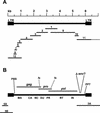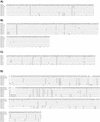Novel endogenous retrovirus in rabbits previously reported as human retrovirus 5
- PMID: 12072509
- PMCID: PMC136318
- DOI: 10.1128/jvi.76.14.7094-7102.2002
Novel endogenous retrovirus in rabbits previously reported as human retrovirus 5
Abstract
Human retrovirus 5 (HRV-5) represented a fragment of a novel retrovirus sequence identified in human RNA and DNA preparations. In this study, the genome of HRV-5 was cloned and sequenced and integration sites were analyzed. Using PCR and Southern hybridization, we showed that HRV-5 is not integrated into human DNA. A survey of other species revealed that HRV-5 is present in the genomic DNA of the European rabbit (Oryctolagus cuniculus) and belongs to an endogenous retrovirus family found in rabbits. The presence of rabbit sequences flanking HRV-5 proviruses in human DNA extracts suggested that rabbit DNA was present in our human extracts, and this was confirmed by PCR analysis that revealed the presence of rabbit mitochondrial DNA sequences in four of five human DNA preparations tested. The origin of the rabbit DNA and HRV-5 in human DNA preparations remains unclear, but laboratory contamination cannot explain the preferential detection of HRV-5 in inflammatory diseases and lymphomas reported previously. This is the first description of a retrovirus genome in rabbits, and sequence analysis shows that it is related to but distinct from A-type retroelements of mice and other rodents. The species distribution of HRV-5 is restricted to rabbits; other species, including other members of the order Lagomorpha, do not contain this sequence. Analysis of HRV-5 expression by Northern hybridization and reverse transcriptase PCR indicates that the virus is transcribed at a low level in many rabbit tissues. In light of these findings we propose that the sequence previously designated HRV-5 should now be denoted RERV-H (for rabbit endogenous retrovirus H).
Figures





Similar articles
-
Single-tube nested quantitative PCR: a rational and sensitive technique for detection of retroviral DNA. Application to RERV-H/HRV-5 and confirmation of its rabbit origin.J Virol Methods. 2003 Jul;111(1):1-11. doi: 10.1016/s0166-0934(03)00127-7. J Virol Methods. 2003. PMID: 12821191
-
Evolutionary studies on the betaretrovirus RERV-H in the Leporidae family reveal an endogenization in the ancestor of Oryctolagus, Bunolagus and Pentalagus at 9 million years ago.Virus Res. 2019 Mar;262:24-29. doi: 10.1016/j.virusres.2017.12.001. Epub 2017 Dec 5. Virus Res. 2019. PMID: 29208424
-
Rabbit endogenous retrovirus-H encodes a functional protease.J Gen Virol. 2003 Jan;84(Pt 1):215-225. doi: 10.1099/vir.0.18670-0. J Gen Virol. 2003. PMID: 12533718
-
[Newly discovered human retroviruses. Association with disease is still undetermined].Lakartidningen. 2000 Aug 23;97(34):3597-9, 3602-3. Lakartidningen. 2000. PMID: 11036380 Review. Swedish.
-
Molecular biology of type A endogenous retrovirus.Kitasato Arch Exp Med. 1990 Sep;63(2-3):77-90. Kitasato Arch Exp Med. 1990. PMID: 1710682 Review.
Cited by
-
Human RNA "rumor" viruses: the search for novel human retroviruses in chronic disease.Microbiol Mol Biol Rev. 2008 Mar;72(1):157-96, table of contents. doi: 10.1128/MMBR.00033-07. Microbiol Mol Biol Rev. 2008. PMID: 18322038 Free PMC article. Review.
-
An overview of the lagomorph immune system and its genetic diversity.Immunogenetics. 2016 Feb;68(2):83-107. doi: 10.1007/s00251-015-0868-8. Epub 2015 Sep 23. Immunogenetics. 2016. PMID: 26399242 Review.
-
Endogenous hepatitis C virus homolog fragments in European rabbit and hare genomes replicate in cell culture.PLoS One. 2012;7(11):e49820. doi: 10.1371/journal.pone.0049820. Epub 2012 Nov 19. PLoS One. 2012. PMID: 23185448 Free PMC article.
-
A new human retrovirus associated with prostate cancer.Proc Natl Acad Sci U S A. 2007 Jan 30;104(5):1449-50. doi: 10.1073/pnas.0610912104. Epub 2007 Jan 23. Proc Natl Acad Sci U S A. 2007. PMID: 17244700 Free PMC article. No abstract available.
-
Uptake of amplifiable fragments of retrotransposon DNA from the human alimentary tract.Mol Genet Genomics. 2003 Dec;270(4):362-8. doi: 10.1007/s00438-003-0930-3. Epub 2003 Oct 11. Mol Genet Genomics. 2003. PMID: 14556071
References
-
- Allen, M. J., A. Collick, and A. J. Jeffreys. 1994. Use of vectorette and subvectorette PCR to isolate transgene flanking DNA. PCR Methods Appl. 4:71-75. - PubMed
-
- Barre-Sinoussi, F., J. C. Chermann, F. Rey, M. T. Nugeyre, S. Chamaret, J. Gruest, C. Dauguet, C. Axler-Blin, F. Vezinet-Brun, C. Rouzioux, W. Rozenbaum, and L. Montagnier. 1983. Isolation of a T-lymphotropic retrovirus from a patient at risk for acquired immune deficiency syndrome (AIDS). Science 220:868-871. - PubMed
-
- Boeke, J. D., and J. P. Stoye. 1997. Retrotransposons, endogenous retroviruses, and the evolution of retroelements. In J. M. Coffin, S. H. Hughes, and H. E. Varmus (ed.), Retroviruses. Cold Spring Harbor Laboratory Press, Cold Spring Harbor, N.Y. - PubMed
Publication types
MeSH terms
Associated data
- Actions
- Actions
- Actions
- Actions
- Actions
- Actions
LinkOut - more resources
Full Text Sources

